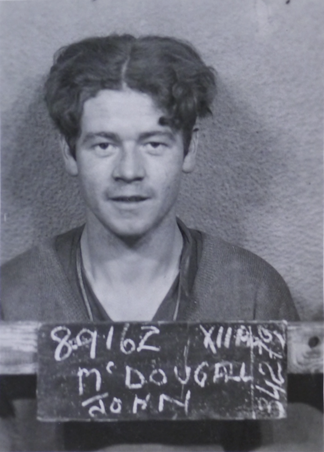John McDougall was the son of Archibald and Mary McDougall, of Johnstone, Renfrewshire. He was born at Johnstone, Renfrewshire, Scotland on the 3 September 1924 so he was just 20 when he served at Arnhem. His service number shows that he was first enlisted into the Argyll & Sutherland Highlanders, possibly as a boy soldier, but transferred to the Royal Artillery, on 25 August 1941, when he was days short of his 17th birthday, and then, later, to the Airborne Forces
John successfully completed his parachute training at RAF Ringway on course number 99 from 19 January to 3 February 1944. His course report stated ‘cheerful, hard worker, reached good standard’.
John served with the 3rd Parachute Battalion at Arnhem was reported as being “Missing” on the 25 September 1944. This was later amended to being known to be a Prisoner of War in German hands however, on 19 February 1945, it was reported that he had died, whilst a POW, on 21 November 1944. The Commonwealth War Graves site shows that he has No Known Grave and is commemorated on the Groesbeek Memorial, Panel 9.
He is shown in German records as being captured on 17th September and initially taken to Stalag XIIA where he was allocated the POW number 89162. On 15th October he was transferred from here to Stalag IVD (Torgau). Here, rather than being employed down the mines or on bomb damage clearance and similar types of work, it would appear that he was immediately sent to work at Kaffeehaus Meuschau, (Coffee House) in Merseburg, some 80 kms west of the main camp.
Just south of Merseburg was the IG Farben Leuna chemical works which produced large quantities of synthetic oil, something which was essential to Germany’s war effort. As such it was a prime target for both USAAF and RAF air raids and multiple raids took place. On 21 November 1944 a large American air raid was launched, dropping hundreds of tons of bombs some of which caused the deaths of about 500 members of the civilian population of Merseburg. Amongst them was John McDougall and it is recorded in his POW records that at 12:00 that day he was killed on the steps of the famous cathedral.
Two days later, at 10:00 hours, he was buried at the “Friedhof at Exerzierplatz Merseburg” (cemetery at the parade ground) in Grave L, 2nd Row, place 2. It is believed that this was one of a number of mass graves in which the casualties of that air raid were buried.
This is almost certainly the main reason why his body was not later recovered but it should also be borne in mind that, after the war, this was part of the area that came under Soviet Control and many such war graves became unrecoverable. Indeed there are specific files at CWGC for “Graves lost in Eastern Germany”.
Submitted by R Hilton and John Howes.
Read More

Latest Comments
There are currently no comments for this content.
Add Comment
In order to add comments you must be registered with ParaData.
If you are currently a ParaData member please login.
If you are not currently a ParaData member but wish to get involved please register.